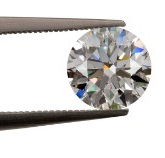Articles and News
DIAMOND GRADING, PART 2: HOW MUCH IS THAT CERTIFICATE REALLY WORTH? | June 15, 2011 (0 comments)

Las Vegas, NV—Diamond dealers, appraisers, and grading lab executives gathered during the annual Rapaport State of the Industry conference at the JCK Show June 5 to address the wide disparities in diamond grading certificates, an issue addressed by The Centurion in its May 26 edition.
Martin Rapaport, chairman of the Rapaport Group, said the lack of self-policing in the industry only serves to undermine consumer confidence, and that he’s considering throwing certain grading labs’ reports off RapNet.
“I realize that the various labs want to differentiate themselves, and that some are tough [at grading] while others are soft, but where do we draw the line?” he asked rhetorically.
It's a genuine conundrum for which the panel--not surprisingly--had no answer.
A Gallup organization report shows that consumers rank jewelers low on the trust scale, along with lawyers and, not surprisingly, car salesmen. But at the same time, consumers want to feel like they are getting a bargain when they shop for jewelry. An exclusive spot-check survey of prestige jewelers by The Centurion found that while fully 100% of respondents felt their business has been adversely affected by inflated diamond grading reports, they said those reports wouldn’t exist without demand. Click here for the full report.
Rapaport asked rhetorically if the "soft" grades really fool anyone in the long run. He presented a sobering valuation chart representing the average price for the average of color, clarity, and cut grades by stone size. Prices were indexed to GIA certificate stones at 100% value.
Here are some of the valuation figures:
|
AVERAGE PRICES FOR THE AVERAGE OF COLOR, CLARITY, AND CUT GRADES BY STONE SIZE, ACCORDING TO THE VARIOUS LABS' CERTIFICATES: GIA HRD AGS IGI EGL USA EGL ISRAEL EGL INTL One carat: 100 86 93 81 65 62 51
1.5 carat: 100 85 92 84 63 64 47
Two carats: 100 86 73 79 54 57 38 Source: RapNet |
Jerry Ehrenwald of the International Gemological Institute (IGI), said it’s the retailer’s responsibility to choose the lab/s they feel are trustworthy. Diamond dealer Ronnie Vanderlinden of Diamex asked how many retailers have GG’s on staff and routinely double-check the labs’ reports when stones come in.
“A retailer can say, ‘we don’t accept this stone’ if their GG’s finding doesn’t match the lab certificate,” he said. “Hopefully someday all the labs will have a level playing field, but till then if it’s not up to par, send it back.”
But Peter Yantzer of AGS Labs said retailers shouldn’t have to worry about checking up on their labs.
“Retailers have to advertise, merchandise, train the staff, and sell the goods. They don’t have time to police the labs,” he said. A retailer who subs out work; i.e. sends stones out for grading, should be able to expect accurate results, he said, garnering applause from the retailers in the audience. Rapaport added, “If you want to sell a low-price stone, sell a low-price stone.” But don’t try to present it as a better stone than it is. It gets to the point where there are so many certs, so many different [grading] languages that it destroys [industry] credibility. If it gets on 60 Minutes or Nightline, that language becomes an issue, he said.
“How bad does it have to get? How many times does it have to get on 60 Minutes?”
Don Palmieri of Gem Certification and Assurance Lab (GCAL) pointed out bluntly that while the debates over diamond grading go on, “if we were selling 18k gold that tested 14k, people would scream bloody murder.”
Ehrenwald brought up insurance companies’ role in the issue. “They’re wise to the game. They’ll replace to the grade of the lab [that issued the certificate],” he said. A stone that would be valued at $20,000 if it had a GIA certificate might only be replaced at $11,000 with another lab’s certificate.
Rapaport again raised the specter of losing consumer confidence.
“We can all agree that grades shouldn’t be off more than one color or one clarity. That’s all the tolerance there should be. We need to self-police, but who’s going to do it and where do you draw the red line?”







